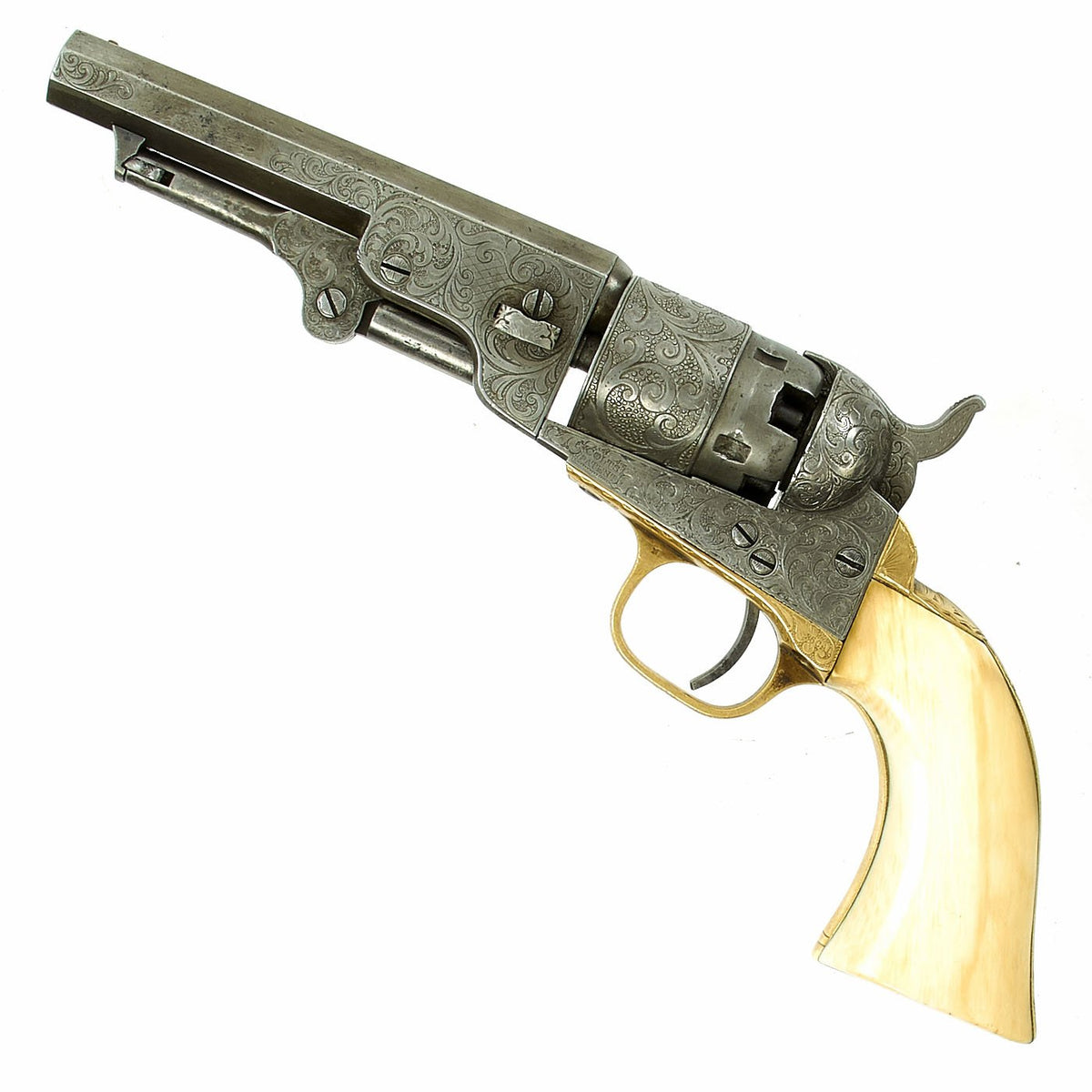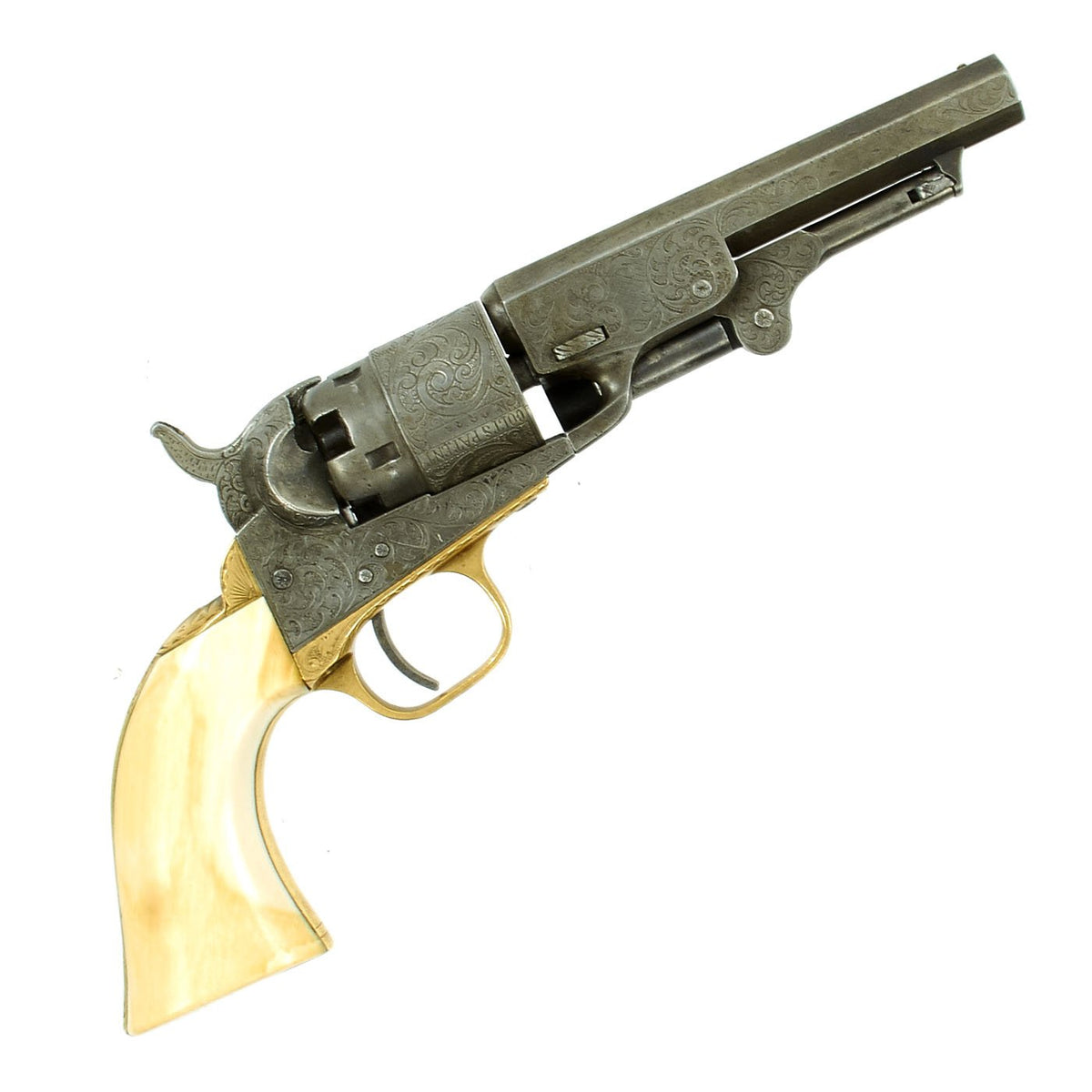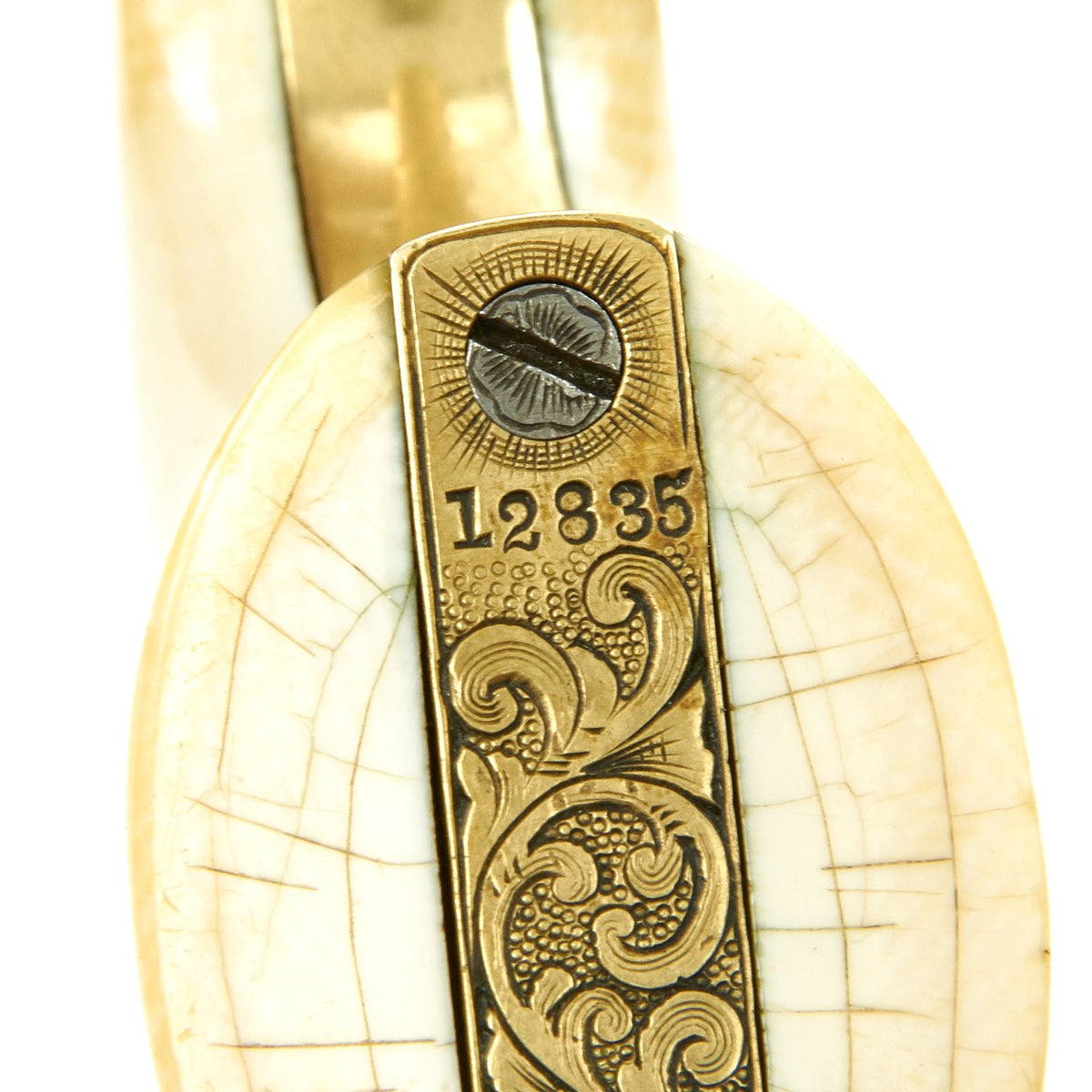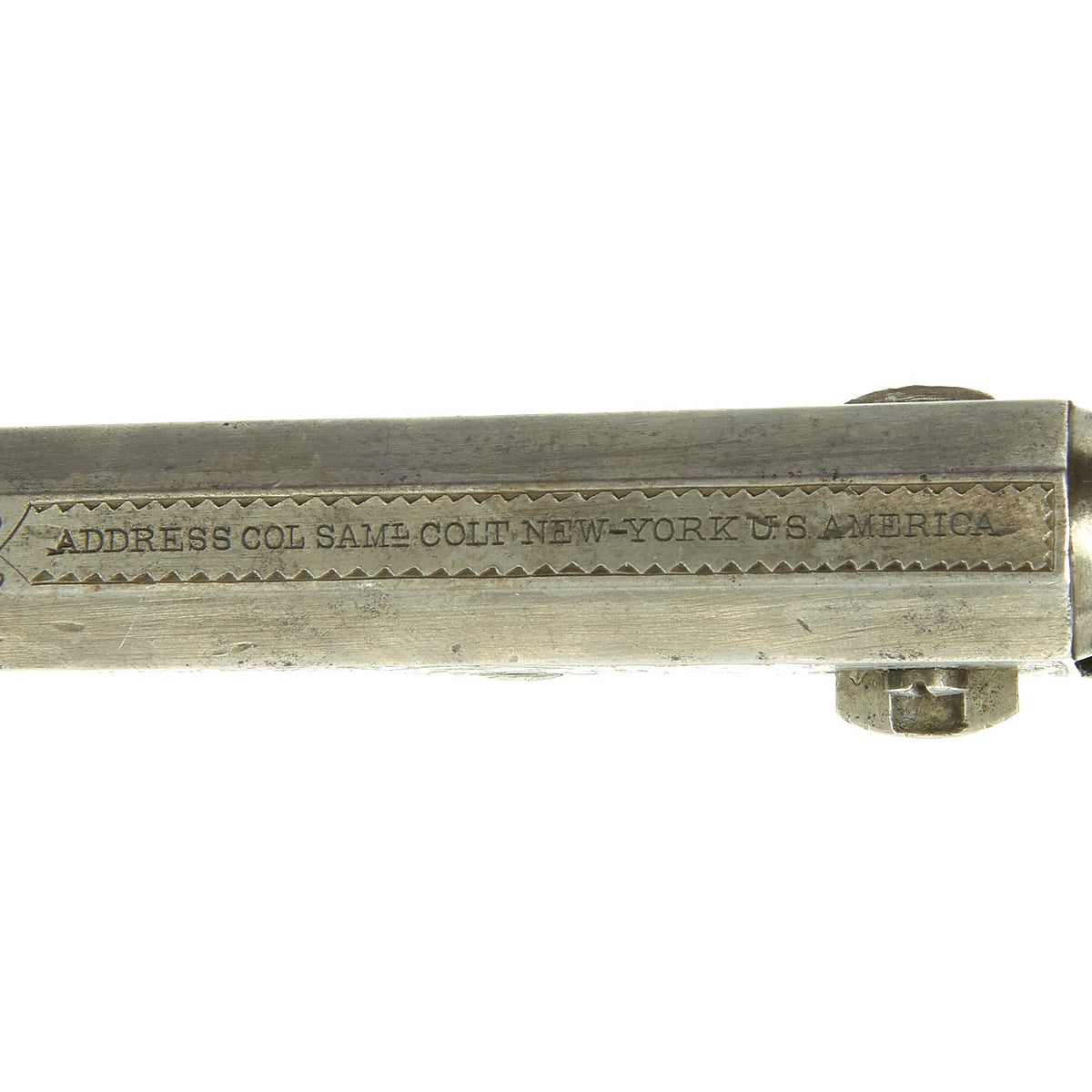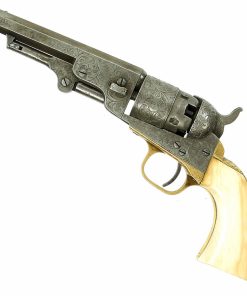Original Civil War Fully Engraved Colt M-1861 Navy Pocket Pistol with Ivory Grips made in 1862 – Serial 12385 Original Items
$ 7.500,00 $ 1.875,00
Original Item: One of a Kind. These are like Hen’s Teeth, just about unfindable and staggeringly rare. In regular Colt Navy .36 Caliber this appears just as a down sized Colt 1851 Navy would appear, with it’s octagonal barrel of 4 1/2″ in length. Overall the revolver measures 9 3/4″ but can still pack a real punch. Introduced in 1862 as the “Pocket Pistol of Navy Caliber”, this 5 shot .36 caliber percussion revolver was often purchased by serving Officers as a reserve handgun carried on the inside of their tunics. This pistol however almost certainly never saw a battlefield.
The condition of this high art example is fabulous, with beautiful full grained Ivory grips in great condition. The trigger guard and back strap are of gilded brass and overall the steel of the revolver is wonderfully engraved. The revolver bears ALL MATCHING serial numbers, with 12385 or 2385 on every visible component of the pistol. This indicates production in 1862, according to Colt firearms records. The side of the frame has a clear COLT’S / PATENT marking, and the trigger guard is marked .36 CAL amidst the engraving, with an N stamped at the front.
Top of the barrel still has the original Colt markings clearly visible:
ADDRESS COL. SAML COLT NEW-YORK U.S. AMERICA
The scroll engraving covering all the steel and brass executed so perfectly it was clearly done by a true master. The question is which Master. There were very high profile New York engravers who did work for Colt and also for Colt distributors. Gustav Young who worked for Colt 1852 – 1869 and Louis Daniel Nimscke, who lived 1832 – 1904, come to mind immediately. However unless you know EXACTLY what to look for one cannot tell which Master it was. There are WEBSITES dedicated to telling the difference but unfortunately we are not expert enough to be able to tell.
Please examine our photographs to satisfy yourself, as this revolver is everything one could hope for. Even the barrel wedge screw is engraved!
Offered from the I.M.A. Collection, just breathtaking, ready to display!
History of the Colt Pocket Percussion Pistols:
The family of Colt Pocket Percussion Revolvers evolved from the earlier commercial revolvers marketed by the Patent Arms Manufacturing Company of Paterson, N.J. The smaller versions of Colt’s first revolvers are also called “Baby Patersons” by collectors and were produced first in .24 to .31 caliber, and later in .36 caliber, by means of rebating the frame and adding a “step” to the cylinder to increase diameter. The .31 caliber carried over into Samuel Colt’s second venture in the arms trade in the form of the “Baby Dragoon”-a small revolver developed in 1847–48. The “Baby Dragoon” was in parallel development with Colt’s other revolvers and, by 1850, it had evolved into the “Colt’s Revolving Pocket Pistol” that collectors now name “The Pocket Model of 1849”. It is a smaller brother of the more famous “Colt’s Revolving Belt Pistol of Naval Caliber” introduced the same year and commonly designated by collectors as the “1851 Navy Model” (and which was a basically a larger, .36 caliber of the Pocket Model, “belt pistol” referring to a weapon sized to fit into a belt holster, as opposed to the saddle holsters generally called for by Colt’s larger cavalry combat models). In 1855 Colt introduced another pocket percussion revolver, the Colt 1855 “Sidehammer”, designed alongside engineer Elisha K. Root.
The Pocket Model revolvers all have a traditional “Colt-style” frame, generally with brass grip straps and trigger guard, and a case-hardened steel frame. In appearance, the frames are almost identical to the larger 1851 Navy and .44 caliber 1860 Army Models, with the exception of being smaller, and so having a proportionately larger trigger guard. Since they appear so similar to the larger weapons, without an object nearby to give them scale, the Pocket Revolvers tend to give an impression of being larger than they actually are; it is difficult to fit all four fingers onto the slender grip, even for a person with average-sized hands. Except for by noting the relative size of the trigger guard to the frame, it is easy for a casual observer to mistake a .31 caliber Model 1849 for an 1851 Navy (un-rebated frame, slab-sided webbing around a regular pivoting loading lever, octagonal barrel, unfluted cylinder); indeed, the Model 1851 Navy was basically no more than a scaled -up 1849 Pocket Model. Likewise, the larger .36 caliber Pocket Police Models are virtually identical to the 1860 Army Model, with rebated frame and stepped cylinder (to accommodate a size up from .31 to .36, instead of .36 to .44 as with the Army Model), a graceful, flowing webbing surrounding a new style “creeping” loading lever, and a round barrel. The most obvious difference is that the Pocket Police had a fluted 5-shot cylinder, while most Army Models were unfluted, and held six shots. The reason for this close similarity is that all four guns were closely related, and followed similar paths of development; the original .31 caliber Model 1849 was scaled up to create the .36 caliber 1851 Navy Model. Later, the Navy Model was increased in bore size by rebating the frame and enlarging the cylinder, and became the 1860 Army Model. With the success of this project, the .31 caliber of the 1849 Model was similarly increased to .36, using the same method, creating the Pocket Police and Pocket Navy models in 1860.
In 1860, the .36 caliber Police Pocket model was created, after lessons were learned from experimentation aimed at reducing the size of the .44 Colt Holster Pistols (i.e. large cavalry weapons), Colt took advantage of stronger mass-produced steel by rebating the frame of the Navy revolver to hold a larger-diameter 44/100-inch chambered cylinder, basically fitting the power of a large cavalry saddle holster-gun and fitting it into the .36 caliber Navy Model, a gun that could be carried in a belt holster. Previously, it wasn’t thought that the smaller frame could handle the power of the .44 round, but the introduction of stronger metals made it possible. Learning the lessons from this, the Colt factory applied the same technology to the .31 caliber Model 1849 Pocket revolvers, using high-strength (for the time) steel for the frame, which allowed them to remove enough material to fit a larger-diameter .36 caliber cylinder which still had five shots (the alternative was to simply retain the original cylinder diameter, and create a 4-shot .36 caliber version. The stronger steels made this sacrifice unnecessary. Other changes including lightweight fluted cylinders, and a round barrel, to offset the added weight, and a “creeping” loading lever as used in the 1861 Army Model; the result was the “Police Pocket Model of 1862”, even though production started in 1861. The Pocket Navy was a version similarly up-sized to .36 caliber, but which retained the octagonal barrel and traditional loading lever of the earlier pocket mode. Between 1862 and 1873, Colt records document production of 19,000 of the Pocket Navies and over 20,000 Pocket Police revolvers. Relative to the .31 Pocket Revolvers, the period of manufacture was short and overall numbers were further limited by a fire at the Colt Factory in 1862 and War production concerns.
Specifications:
Year of Manufacture: 1862
Caliber: .36cal
Ammunition Type: Cap and Ball
Barrel Length: 4 1/2 inches
Overall Length: 9 3/4 inches
Action: Single Action
Feed System: 5 Shot Revolver
NOTE: International orders of antique firearms MUST be shipped using UPS WW Services (courier). USPS Priority Mail international will not accept these.
Fast Shipping with Professional Packaging
Thanks to our longstanding association with UPS FedEx DHL, and other major international carriers, we are able to provide a range of shipping options. Our warehouse staff is expertly trained and will wrap your products according to our exact and precise specifications. Prior to shipping, your goods will be thoroughly examined and securely secured. We ship to thousands clients each day across multiple countries. This shows how we're dedicated to be the largest retailer on the internet. Warehouses and distribution centres can be located throughout Europe as well as the USA.
Note: Orders with more than one item will be assigned a processing date depending on the item.
Before shipping before shipping, we'll conduct a thorough inspection of the items you have ordered. Today, the majority of orders will be delivered within 48 hours. The delivery time will be between 3-7 days.
Returns
The stock is dynamic and we cannot completely manage it because multiple stakeholders are involved, including our factory and warehouse. So the actual stock may alter at any time. It's possible that you may not receive your order once the order has been made.
Our policy is valid for a period of 30 days. If you don't receive the product within 30 days, we are not able to issue a refund or an exchange.
You can only return an item if it is unused and in the same state as the day you received it. You must have the item in its original packaging.
Related products
Uncategorized
Uncategorized
Armored Burgonet Helmet & Polearm from Scottish Castle Leith Hall Circa 1700 Original Items
Uncategorized
Uncategorized
Uncategorized
Uncategorized
Uncategorized
Uncategorized
Uncategorized
Uncategorized
Uncategorized
Uncategorized
Uncategorized
Uncategorized
Uncategorized
Uncategorized
